Thoney Pietro House
Introduction
Text-to-speech Audio
Images
Historical photograph of the Thoney Pietro House
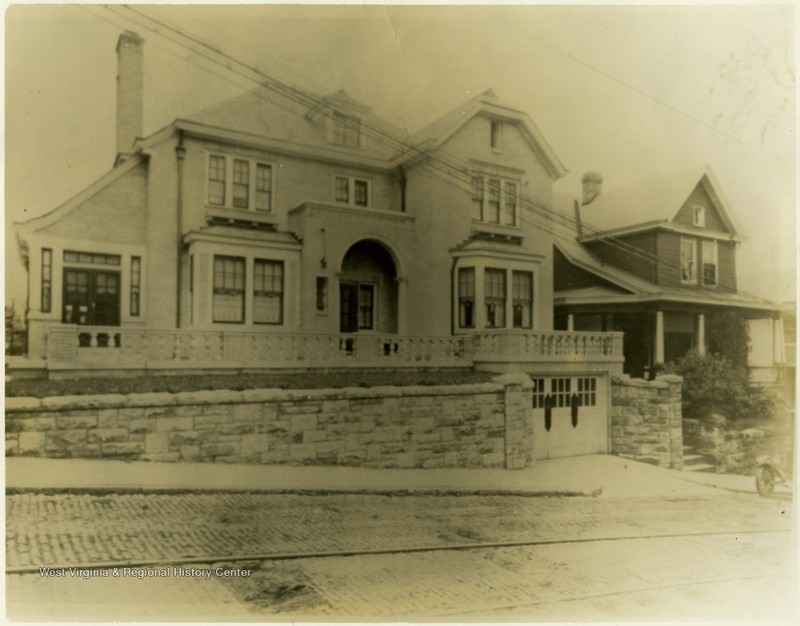
Thoney Pietro House today
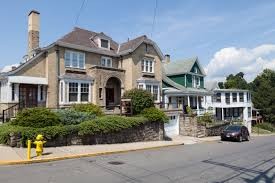
Portrait of Thoney Pietro
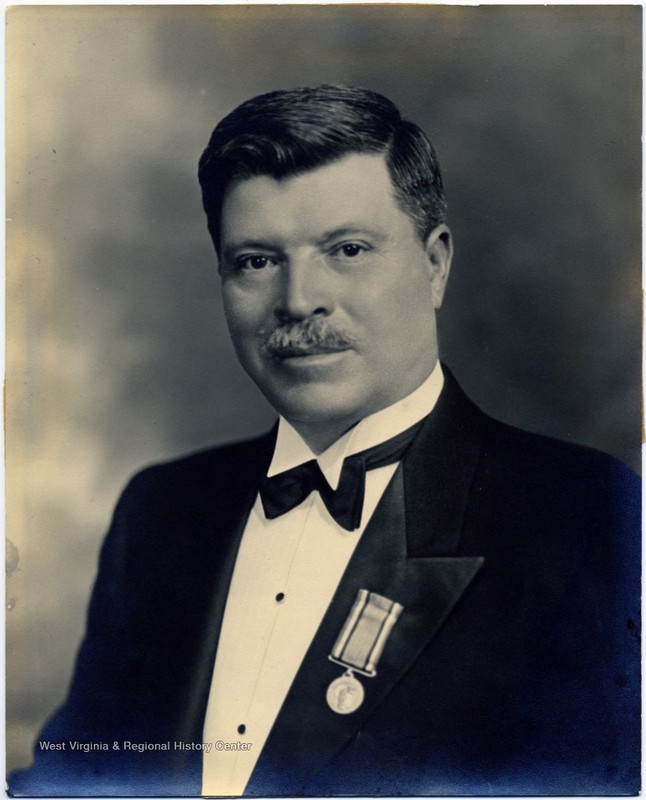
Newspaper article lauding Pietro's skill
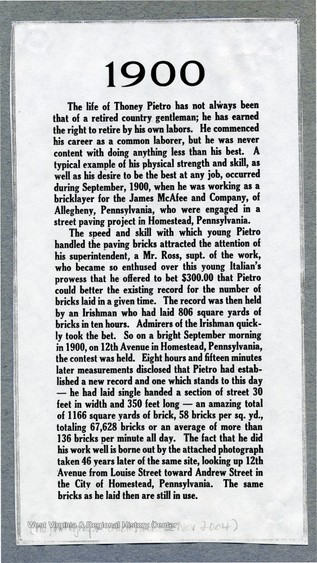
The Thoney Pietro Construction Company at work paving Richwood Avenue
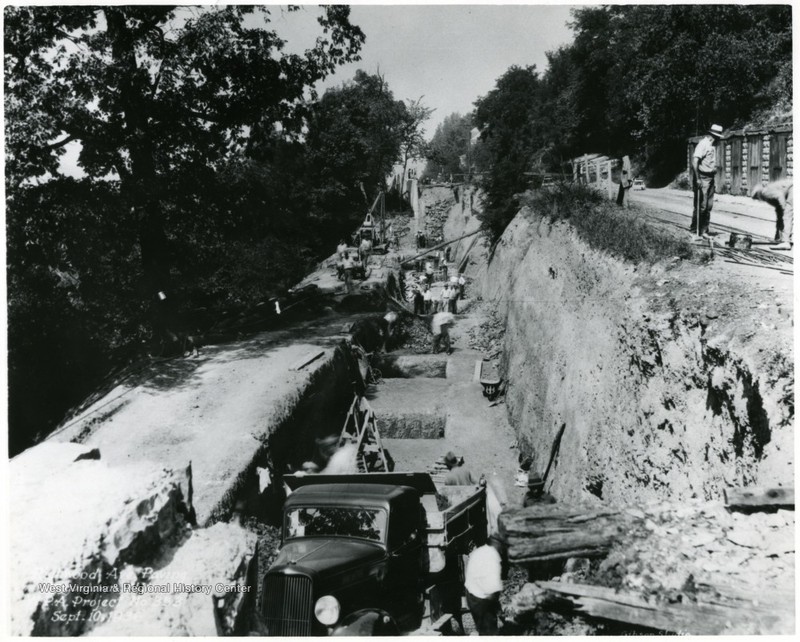
Backstory and Context
Text-to-speech Audio
Ferdinando Pitassi (or Pitasswi) was born in Genoa, Italy in 1878. At only seven years old he began an apprenticeship with his grandfather, an accomplished stonemason. By the time Pitassi immigrated to the United States in 1896, he was extremely skilled in his own right. At the immigration office, an administrator was unable to pronounce Pitassi, so the new American changed it to Pietro, similar to the Italian “pietra,” meaning stone. Pietro initially settled in Pittsburgh, PA and began working for various constructing companies. It was during this period that Pietro’s first name also changed. A boss at one company referred to all Italian workers as Tony. Pietro leaned into the stereotyping but added letters to claim Thoney as his own. He married in the late 1890s.
Pietro’s reputation as a master mason developed extremely rapidly in Pittsburgh. In 1900, he was challenged to a brick-laying contest which is detailed by a news clipping:
“The speed and skill with which young Pietro handled the paving bricks attracted the attention of his superintendent, a Mr. Ross, supt. of the work, who became so enthused over the young Italian's prowess that he offered to bet $300.00 that Pietro could better the existing record for the number of bricks laid in a given time, The record was then held by an Irishman who had laid 806 square yards of brick in ten hours. Admirers of the Irishman quickly took the bet. So on a bright September morning in 1900, 0n 12th Avenue in Homestead, Pennsylvania, the contest was held. Eight hours and fifteen minutes later measurements disclosed that Pietro had established a new record and one which stands to this day - he had laid single handed a section of street 30 feet in width and 350 feet long- an amazing total of 1166 square yards of brick, 58 bricks per sq. yd., totaling 67,628 bricks or an average of more than 136 bricks per minute all day.”1
Evidently, Pietro’s skill translated well into compensation, as he took many vacations with his wife. On one excursion, they traveled to Fairmont via the Monongahela River and Pietro saw Morgantown from a boat. It reminded him so strongly of his native Italy that he promised his wife they would move there someday, and in the late nineteenth century, they did.
Once in Morgantown, Pietro established the Thoney Pietro Construction Company in partnership with several of his brothers. This company was instrumental to establishing the burgeoning infrastructure in Morgantown and was the major contractor in the area for the Works Progress Administration. It was responsible for paving High Street, Spruce Street, University Avenue, Brockway Avenue, Richwood Avenue, and many others. The Thoney Pietro Construction Company also built many of the retaining walls in the South Park neighborhood, and the nearby Morgantown High School athletic field. By the 1920s, the company had offices in Baltimore, Philadelphia, and throughout the state of West Virginia. Pietro decided to build his dream home, styled on a castle in Italy, and it was completed in 1933. The building became known as Pietro’s Castle, and the Pietro family lived there until 1949. When Pietro deeded his castle to the Franciscan Friars in 1949, the family moved to the house on Kingwood street.
Pietro was actively involved in local communities, especially regarding Italian culture. In the 1930s he successfully petitioned for Italian language to be taught in Monongalia County public schools. Pietro was also a member of the American Italian Congress. A letter he wrote to a Morgantown newspaper attracted national attention and was republished in many larger newspapers. In the letter he urged the American Government to adopt a policy of non-interference in Italian colonies in Africa, or if the Americans insisted on intervention, to at least place Italian-Americans in charge of the colonies. Pietro also commissioned a bust of the Italian writer Dante Alighierhi to be given to the West Virginia University Libraries as a token of his appreciation for the happiness he had found in America. In addition to his representation of Italy and Italians, Pietro was also an advocate for labor rights. He paid his workers $2.40 during the Great Depression; over double the standard wage.
Pietro’s Kingwood Street home is significant for several reasons. The tudor revival building has a distinctly Italianate flavor. Despite having the financial means to live anywhere in Morgantown, Pietro chose the site of his new house in an area home to many poorer Italian immigrant laborers. Pietro cast his lot with fellow immigrants and Italians in a display of pride for both his ethnic culture and his status as an American. Additionally, the yellow brick tudor revival draws parallels to industry. It seems that Pietro never forgot his own origins as a laborer, nor did his skill seem to fade. When a West Virginia University student came to interview the 78 year old Pietro, the mason laid 111 bricks in less than a minute. Pietro died in Morgantown in 1972 and the street behind his Kingwood home was named Pietro Street in his honor. Pietro’s mark was left on the area through his improvements to Morgantown and through his advocacy for workers and Italian-Americans. These days, the Thoney Pietro House serves as offices for a rental company.
Sources
Exhibit: Thoney Pietro: A Morgantown Visionary. Morgantown History Museum News. 1 - 1.
Fuller, J Patrick. The Castle, August 4th 2010. Accessed September 2nd 2020. http://everipedia-storage.s3.amazonaws.com/NewlinkFiles/17042367/cbfe0___/fuller-doctor-j-patrick-the-castle-brevard-communi.pdf.
"Seek Restoration of Colonies to Italians." Indiana Gazette (Indiana) May 8th 1946. , 9-9.
1. Testament to the Brick Laying Prowess of Thoney Pietro, West Virginia and Regional History Center. Accessed September 3rd 2020. https://wvhistoryonview.org/catalog/032596.
Thompson, Griffin. The Development of Architecture in South Park Community, Morgantown, WV, Accessed September 3rd 2020. https://slideplayer.com/slide/8067453/.
Thoney Pietro, Contractor, Papers. Morgantown, WV. West Virginia and Regional History Center.
Who Built Morgantown, Morgantown Magazine. June 29th 2017. Accessed September 3rd 2020. https://morgantownmag.com/who-built-morgantown/.
West Virginia & Regional History Center
Wikimedia
West Virginia & Regional History Center
West Virginia & Regional History Center
West Virginia & Regional History Center
